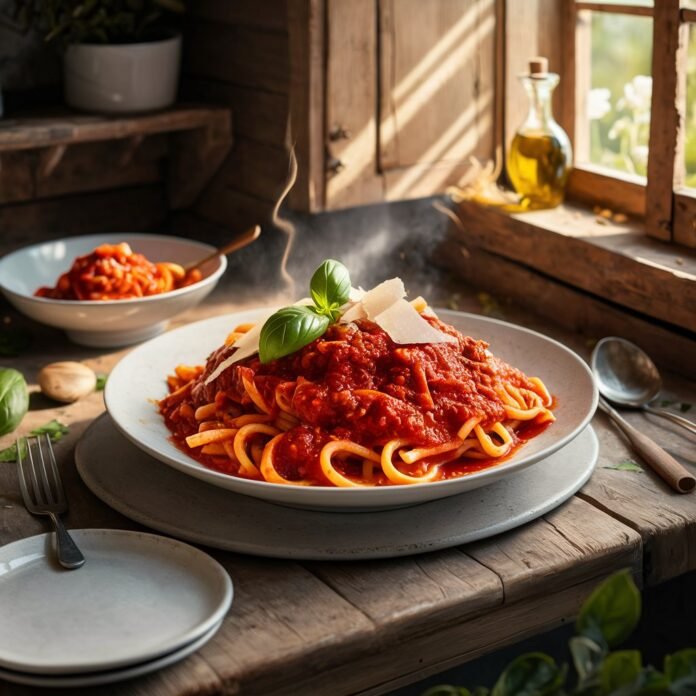Introduction
A distinctive and versatile pasta stands out with its unique characteristics and rich history. Often confused with other pasta varieties, bucatini, also known as perciatelli, is a thick, spaghetti-like noodle with a hole running through the center. This guide will delve deep into the world, exploring its origins, culinary uses, and tips for cooking. Whether you’re a food enthusiast or just looking to diversify your pasta repertoire, this comprehensive article on bucatini will provide you with everything you need to know.
Bucatini, also known as perciatelli, is a thick spaghetti-like pasta with a hole running through the center. It is commonly found in Lazio, especially in Rome.
What is Bucatini?
Bucatini is a type of pasta that originates from the Lazio region of Italy, particularly Rome. It resembles spaghetti but is thicker and has a hollow center, which is a defining feature of this pasta. The name “bucatini” comes from the Italian word “buco,” meaning “hole,” which perfectly describes its unique structure.
Characteristics
- Shape: It is cylindrical with a diameter larger than spaghetti. The hollow center is what differentiates it from other pasta shapes.
- Texture: The outer surface is smooth, while the hollow center allows it to hold sauces and flavors more effectively.
- Size: Typically, bucatini is about 2-3 mm in diameter and can be found in various lengths, usually ranging from 20-30 cm.
History
Bucatini has a rich history that dates back to Italy’s culinary traditions. Its origins are deeply rooted in Roman cuisine, where it has been enjoyed for centuries. The pasta’s unique shape and texture are a result of traditional pasta-making techniques that have been perfected over time.
Traditional Uses in Italian Cuisine
In Italy, is commonly used in various classic dishes, particularly those from the Lazio region. Its hollow center makes it ideal for soaking up rich, flavorful sauces. Traditional recipes include:
- Bucatini all’Amatriciana: A classic Roman dish made with a tomato-based sauce, guanciale (cured pork cheek), and Pecorino Romano cheese.
- Bucatini cacio e pepe: A simple yet delicious recipe featuring cheese and black pepper sauce.
- Bucatini alla Carbonara: A variation of the famous carbonara made with eggs, cheese, pancetta, and black pepper.
Tips and Techniques
Cooking correctly is essential to achieving the perfect texture and flavor. Here are some expert tips to help you get it right:
1. Boiling Bucatini
- Use Plenty of Water: Make sure to use a large pot of boiling water for cooking. This helps to prevent the pasta from sticking together.
- Salt the Water: Add a generous amount of salt to the boiling water before adding. This enhances the pasta’s flavor.
- Cook Until Al Dente: it should be cooked until al dente, meaning it should be firm to the bite. Follow the package instructions for cooking time, but taste a piece a minute or two before the recommended time is up.
2. Draining and Tossing
- Reserve Some Pasta Water: Before draining, reserve a cup of pasta water. It can be used to adjust the consistency of the sauce later.
- Avoid Overcooking: Overcooked can become mushy, so make sure to monitor the cooking process closely.
- Toss with Sauce Immediately: After draining, toss bucatini with your chosen sauce immediately to ensure it absorbs the flavors well.
Pairing Bucatini with Sauces
Bucatini’s hollow center makes it perfect for pairing with a variety of sauces. Here are some popular options:
1. Tomato-Based Sauces
- Marinara: A classic tomato sauce with garlic, onions, and herbs.
- Arrabbiata: A spicy tomato sauce with red chili flakes.
2. Creamy Sauces
- Alfredo: A rich, creamy sauce made with butter, cream, and Parmesan cheese.
- Carbonara: A creamy sauce with eggs, cheese, and pancetta.
3. Pesto and Herb Sauces
- Basil Pesto: A fresh, herbaceous sauce made with basil, garlic, pine nuts, and Parmesan.
- Spinach and Ricotta: A creamy, green sauce with spinach and ricotta cheese.

Bucatini vs. Other Pasta Shapes
Compared to other pasta shapes can help highlight its unique characteristics and uses:
1. Bucatini vs. Spaghetti
- Shape: it is thicker and has a hollow center, while spaghetti is thin and solid.
- Texture: it holds sauces better due to its hollow center, whereas spaghetti may not hold sauces as well.
2. Bucatini vs. Penne
- Shape: it is long and cylindrical, while penne is short and tube-shaped.
- Sauce Compatibility: it is ideal for long, rich sauces, while penne works well with chunky sauces.
Nutritional Information
Understanding the nutritional content can help you make informed choices:
1. Basic Nutritional Profile
- Calories: Approximately 200 calories per 2-ounce serving.
- Carbohydrates: Around 40 grams per serving.
- Protein: About 7 grams per serving.
- Fat: Typically low in fat, with around 1 gram per serving.
2. Health Considerations
- Whole Wheat Options: For a healthier alternative, consider using whole wheat, which is higher in fiber and nutrients.
- Portion Control: Be mindful of portion sizes to maintain a balanced diet.
Recipes Feature
Here are a few recipes to get you started:
1. Bucatini all’Amatriciana
Ingredients:
- Bucatini
- Guanciale or pancetta
- Tomato sauce
- Pecorino Romano cheese
- Red chili flakes
- Garlic and onion
Instructions:
- Cook according to package instructions.
- In a pan, cook guanciale until crispy.
- Add garlic and onion, then stir in tomato sauce.
- Toss cooked with the sauce and sprinkle with Pecorino Romano and red chili flakes.
2. Bucatini cacio e pepe
Ingredients:
- Pecorino Romano cheese
- Black pepper
- Salt
Instructions:
- Cook bucatini until al dente.
- Toss pasta with freshly grated Pecorino Romano and cracked black pepper.
- Add a bit of reserved pasta water to create a creamy sauce.
FAQs
1. What is the difference between bucatini and spaghetti?
It is thicker than spaghetti and has a hollow center, which allows it to hold more sauce. Spaghetti is thinner and solid throughout.
2. Can I use bucatini in place of spaghetti in recipes?
Yes, can be used in place of spaghetti in most recipes. Its unique shape may slightly alter the texture of the dish but can enhance the flavor by holding more sauce.
3. How do I store leftover bucatini?
Store leftovers in an airtight container in the refrigerator for up to 3-4 days. Reheat in a pan with a bit of water or sauce to prevent it from drying out.
4. Is bucatini available in whole wheat or gluten-free options?
Yes, many stores offer whole wheat and gluten-free versions of bucatini for those with dietary preferences or restrictions.
Conclusion
Bucatini is a versatile and delicious pasta that adds a unique twist to traditional dishes. Its hollow center and thick texture make it ideal for holding rich sauces and enhancing flavors. Whether you’re preparing classic Italian recipes or experimenting with new dishes, it is a fantastic choice for any pasta lover.
By understanding the history, cooking techniques, and recipe ideas, you can elevate your pasta game and enjoy this delightful pasta in various delicious ways. So, grab some experiment with your favorite sauces, and savor the delightful flavors this pasta has to offer!




